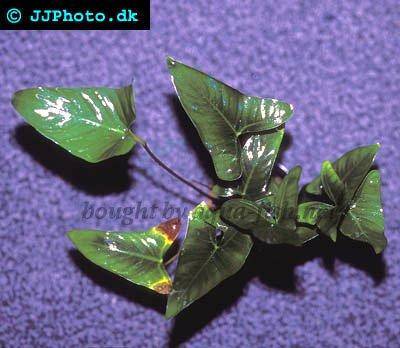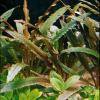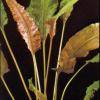Anubias gracilis
Scientific name: Anubias gracilis
Family: Araceae
Maximum size reached under cultivation: 20 - 60 cm (7.87 - 23.62 inch)
014
Recommended pH range: 5.6 - 8
Recommended water hardness: 5 - 18°dGH (89.29 - 321.43ppm)
0°C 32°F30°C 86°F
Recommended temperature range: 20 - 30 °C (68 - 86°F)
Preferred propagation method: Rhizome
Native to: Africa
Growth rate: Slow
Recommended substrate: Fine gravel
Lighting requirements: Medium
Ideal placement in tank: Background
🌿 Common Names
Spade-Leaf Anubias
🌍 Origin
Anubias gracilis is native to the tropical regions of West Africa, particularly in Sierra Leone and Guinea. It naturally grows along shaded riverbanks, marshes, and wetlands, thriving in warm, humid environments. Thanks to its robust nature and tolerance for low light, it is well-suited for both aquariums and high-humidity setups such as paludariums.
🌱 Growing Conditions
Anubias gracilis is a hardy, versatile plant that thrives both fully submerged in aquariums and emersed in humid environments like paludariums or pond edges. It prefers moderate lighting but adapts well to low-light conditions, making it a reliable choice for low-tech setups. This flexibility allows for varied placement without requiring high-intensity lighting.
With its slow growth rate, Anubias gracilis can reach up to 20–60 cm (7.87–23.62 inches) in height, making it ideal for background planting. It grows best under stable conditions with a pH range of 5.6–8 and water hardness between 5–18 dGH. Preferred temperature is 20–30 °C (68–86 °F). For optimal results, anchor the plant in fine gravel or attach it to rocks or driftwood, ensuring the rhizome remains above the substrate to prevent rot.
💡 Lighting Requirements
Anubias gracilis performs best under moderate light but can thrive in low-light conditions. In high-intensity lighting, algae may develop on the leaves, so placing the plant in partially shaded areas—such as beneath tall plants or décor—can help control buildup. A photoperiod of 8–10 hours daily supports healthy, consistent growth.
📍 Planting Area
Due to its height and upright structure, Anubias gracilis is best used in the background of aquariums, where it adds vertical dimension and lush greenery. It pairs well with driftwood, rocks, and decorative caves, creating a natural environment and offering cover for shy or nocturnal fish. Ensure the plant has sufficient space, as crowded conditions may hinder its development.
🔗 Propagation
Anubias gracilis is propagated through rhizome division. Cut a portion of the rhizome with several leaves attached, and secure it to rocks or driftwood using thread or aquatic glue. You may also lay it gently on the substrate surface. New shoots and roots will develop gradually. Avoid burying the rhizome, as this can lead to decay.
⚙️ Difficulty
This species is easy to care for, making it suitable for aquarists of all experience levels. Its ability to tolerate a broad range of conditions, combined with its slow growth, means it requires minimal pruning. Occasional fertilization supports overall health, and its thick, tough leaves deter most herbivorous fish, ensuring longevity in community setups.
📝 Short Description
Anubias gracilis, also known as Spade-Leaf Anubias, is a popular choice for background planting thanks to its tall, elegant, spade-shaped leaves and rich green tones. Its slow growth and low maintenance make it a favorite for aquariums seeking natural, long-lasting structure. While older leaves may gather some algae, this often enhances the plant’s natural appearance. In optimal conditions, it thrives in both submerged and emersed environments and may occasionally flower in humid setups. Always ensure the rhizome is securely anchored above the substrate to avoid disturbance or rot.
❓ Frequently Asked Questions (FAQ)
- 📏 How tall does Anubias gracilis grow?
It can reach up to 60 cm (23.6 inches), making it an excellent background plant in larger aquariums. - 💧 Can it grow fully submerged?
✅ Yes, it thrives both submerged in aquariums and emersed in paludariums or high-humidity environments. - 💨 Does it need CO2?
Not required, but low-level CO2 supplementation can help improve leaf color and overall vitality. - 🌿 How do I attach it?
Use plant-safe thread, rubber bands, or aquarium glue to attach the rhizome to rocks or driftwood. Avoid burying it in the substrate. - 🐟 Is it safe with herbivorous fish?
🛡️ Yes, its tough, leathery leaves are typically not appealing to plant-nibbling species like goldfish or cichlids. - 🌞 What causes algae on its leaves?
Too much direct light or poor water flow. Try placing it in shaded areas and maintain gentle current near the plant. - ✂️ How often should I prune it?
Rarely. Its slow growth rate means you may only need to trim damaged or aging leaves every few months.

 Aglaonema commutatum “Silver Queen”
Aglaonema commutatum “Silver Queen” Aglaonema simplex
Aglaonema simplex Anubias afzelii
Anubias afzelii Anubias barteri
Anubias barteri Anubias barteri “Caladiifolia” ‘1705’
Anubias barteri “Caladiifolia” ‘1705’ Anubias barteri “Coffeefolia”
Anubias barteri “Coffeefolia” Anubias barteri “Nana”
Anubias barteri “Nana” Anubias barteri v. angustifolia
Anubias barteri v. angustifolia Anubias heterophylla
Anubias heterophylla Cryptocoryne affinis
Cryptocoryne affinis Cryptocoryne albida
Cryptocoryne albida Cryptocoryne balansae
Cryptocoryne balansae Cryptocoryne becketti
Cryptocoryne becketti Cryptocoryne blassi
Cryptocoryne blassi Cryptocoryne ciliata
Cryptocoryne ciliata Cryptocoryne cordata
Cryptocoryne cordata Cryptocoryne lutea
Cryptocoryne lutea Cryptocoryne nevillii
Cryptocoryne nevillii Cryptocoryne petchii
Cryptocoryne petchii Cryptocoryne pontederiifolia
Cryptocoryne pontederiifolia Cryptocoryne wendtii
Cryptocoryne wendtii Cryptocoryne willisii
Cryptocoryne willisii Lagenandra ovata
Lagenandra ovata Lemna minor
Lemna minor Pistia stratiotes
Pistia stratiotes Spathiphyllum petite
Spathiphyllum petite Spathiphyllum wallisii
Spathiphyllum wallisii